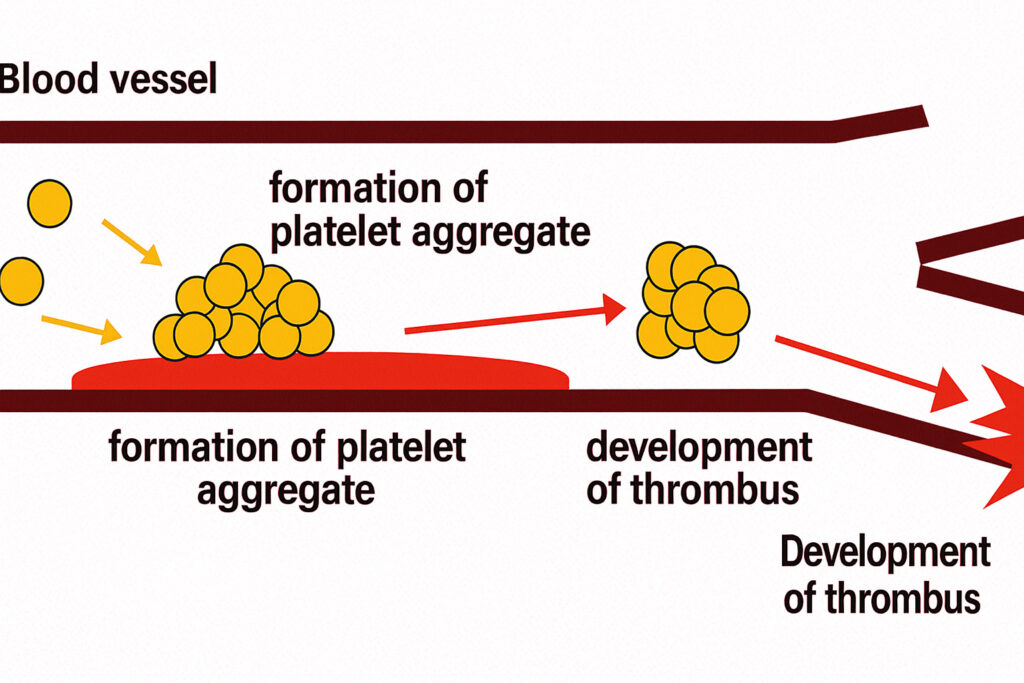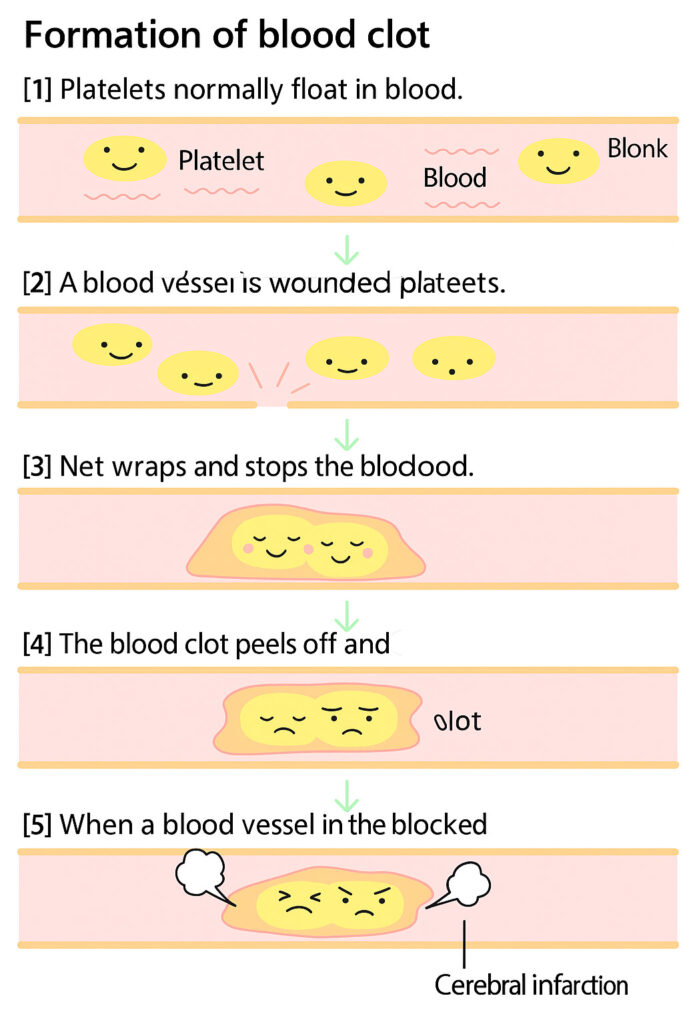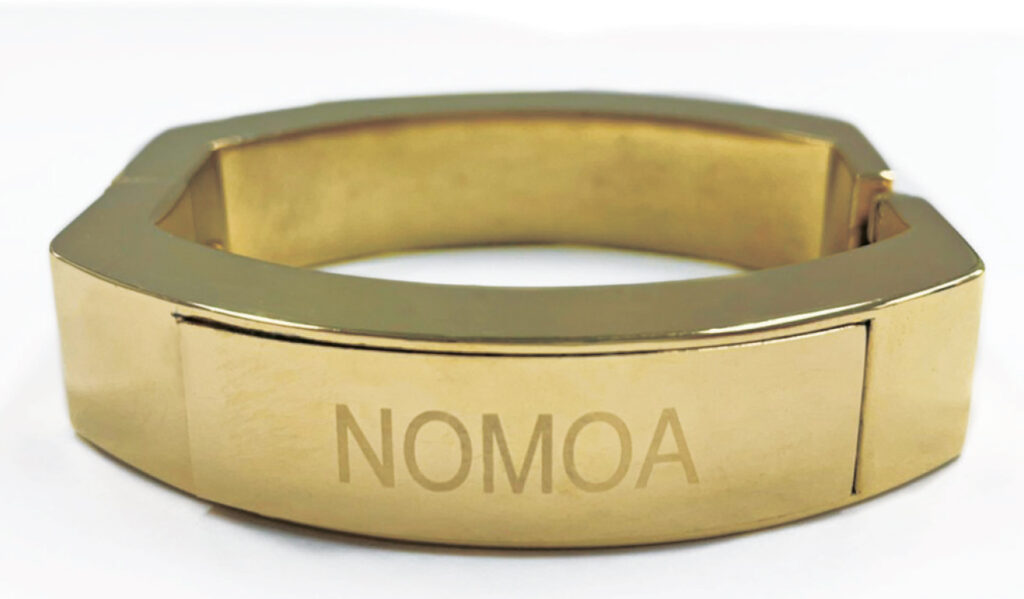What is thrombosis?
Cancer, heart disease, and cerebrovascular disease are the world’s leading causes of death. Of these, myocardial infarction accounts for 90% of cardiovascular diseases, and cerebral infarction, which accounts for the majority of cerebrovascular diseases, is caused by thrombosis, in which a blood clot forms in a blood vessel and stops blood flow.
Thrombosis is characterized by a sudden onset, the possibility of residual functional impairment, and the possibility of recurrence. Thrombosis often occurs suddenly and is asymptomatic until one second before the onset. The scary thing about thrombosis is that a seemingly healthy person can become seriously ill in an instant. In addition, paralysis may remain after the onset of the disease even if it is treated, and it may recur even after treatment.
Thrombosis can be triggered by lifestyle disorders such as smoking, eating and drinking too much fatty food, lack of sleep, lack of exercise, and stress, as well as blood contamination and stagnation caused by active oxygen.
It is important to prevent thrombosis before it occurs.
Thrombosis classification
Arterial thrombosis
Arterial thrombosis is a thrombosis in an environment with rapid blood flow. Cerebral infarction and myocardial infarction are typical examples of this disease. When blood flow is fast, platelets are easily activated and a thrombus with a high platelet content (platelet thrombus) is formed.
Venous thrombosis
Venous thrombosis is a thrombosis in an environment with slow blood flow. Typical examples are deep vein thrombosis and cerebral infarction caused by atrial fibrillation. When blood flow is slow, coagulation is easily activated and a clot (coagulated thrombus) with a high content of fibrin (the end product of coagulation activation) is formed.
Causes and characteristics

Obstruction of blood flow
Blood stagnation and thrombosis occur when there is an obstruction to blood flow. For example, working at a desk, flying for a long time, watching movies for a long time, or resting for a long time after surgery or childbirth can cause blood flow to stagnate. This is when the role of the lower limbs becomes important.
In the first place, blood flow in the lower part of the body is controlled by the contraction of the large muscles in the calves and thighs, which act like a pump, carrying the blood flow in the lower limbs to the heart and allowing blood to circulate throughout the body. However, if the lower part of the body is immobile due to prolonged sitting, the pumping function of the muscles does not work, and blood clots can form in the lower limbs.
Blood clots form easily
Blood clots are also formed when the blood clots and becomes difficult to flow. This is especially common in chronic diseases such as hyperlipidemia and diabetes. Once the blood starts to clot, a significant number of blood clots in a matter of seconds. Blood that encounters the clot will form another clot, and then blood will hit the newly formed clot and form another clot, and so on, creating a chain of events in which blood flowing one after another form clots. If the clot completely blocks the blood vessel and blood cannot flow, the tissue that has lost its blood supply will die. This is known as an infarction.
Arrhythmia
Most arrhythmias are harmless, but they can be dangerous if you suddenly lose consciousness, feel dizzy when you move your body, or if your heart suddenly starts palpitating. Atrial fibrillation is one of the most common arrhythmias that can occur in old age and can cause very strong palpitations. Atrial fibrillation does not kill you immediately, but if the condition persists, blood clots (thrombus) can easily form in the atria. If the blood clot gets stuck in a blood vessel in the brain, a stroke will occur. In addition, since the heart is always running at full speed, if this condition persists for a long time, the heart muscle will weaken, increasing the possibility of heart failure.
Arteriosclerosis

Atherosclerosis is a condition in which blood vessels lose their suppleness and harden as they age, and cholesterol- and lipid-laden blood adheres to the vessels, causing them to become thinner and the flow of blood to become sluggish. In healthy blood vessels, blood flows without stagnation, but when arteriosclerosis causes blood flow to stagnate in a blood vessel, blood tends to clot there, forming a blood clot. A cerebral infarction or myocardial infarction occurs when a blood clot formed in a blood vessel of the brain or a blood clot carried from the heart obstructs the blood vessel.
Initial symptoms
You may have an image that cerebral infarction and myocardial infarction occur suddenly, but there are signs. For example, in the case of cerebral infarction, the symptoms of a transient ischemic attack will subside in a few minutes at the shortest or 30 minutes at the longest. Typical examples of transient ischemic attacks are aphasia, which is a sudden loss of speech, and speech disturbance, which is a loss of speech. Other symptoms that may appear without any cause are as follows:
– Sharp chest pain, sudden shortness of breath
– Crushing pain in the chest
– Severe headache, dizziness, fainting, visual or speech disturbances
– Weakness or paralysis of one limb on either side
– Loss of vision on one side
– Facial paralysis on one side
The initial symptoms are caused by a temporary clogging of blood vessels by a blood clot, and since the clot is not completely blocked, the symptoms will go away in a few minutes. Even if the symptoms are only temporary, it is possible that the blood vessels are becoming more easily clogged, and in such cases, it is advisable to seek medical attention.
Improvement and prevention measures
Cholesterol, blood pressure, and blood sugar management
High cholesterol can block blood vessels and reduce blood flow, which can lead to myocardial infarction and stroke. The risk of heart disease and stroke is more than four times higher in people with diabetes than in those without.
One of the major causes of thrombosis is arteriosclerosis. Hypertension, hyperlipidemia, diabetes, and heart diseases such as atrial fibrillation are some of the conditions that promote this arteriosclerosis and damage blood vessels. The causes of these diseases are smoking, drinking, obesity, and other lifestyle disorders. There are risk factors lurking in our daily lives. Since atherosclerosis has no subjective symptoms, it is important to reduce bad cholesterol and strengthen the elasticity of blood vessels by taking care to improve diet and lack of exercise on a daily basis.
Reactive oxygen species are deeply involved in atherosclerosis
It has been said that atherosclerosis, which is believed to cause thrombosis, is only caused by excessive intake of cholesterol. It has been thought that the bad cholesterol enters the blood vessel wall and causes the vessel to become blocked and clogged, but in fact, the bad cholesterol is oxidized by the reactive oxygen species generated in the body, and the hard bad cholesterol oxidized and hardened by the oxidation is the cause of atherosclerosis.
The volume of the bad cholesterol oxidized and oxidized and hardened by the active oxygen swells up, lifts up the inner membrane of the blood vessel, and narrows the inside of the vessel. The blood vessel wall in that area becomes brittle, and the blood vessel itself loses its elasticity and becomes stiff. In this way, arteriosclerosis progresses.
In this way, we can see how active oxygen corrodes blood vessels, and that active oxygen is the main cause of arteriosclerosis.
Solution
About reactive oxygen species
Oxygen taken into the body through respiration combines with hemoglobin in the blood and is transported to the cells of each tissue in the body. The oxygen that leaves the hemoglobin due to stress or other factors while traveling through the blood vessels becomes reactive oxygen species, which oxidize the surrounding cells and cholesterol in a disorderly manner. Excessive lack of exercise, unbalanced diet, stress, smoking, etc. can produce reactive oxygen species in the blood, and the resulting oxidative stress can cause aging and aging-related high blood pressure, arteriosclerosis, myocardial infarction, and cerebral infarction.
Relationship between reactive oxygen species and aging
When cells are attacked by reactive oxygen species, the lipids in the cell membranes of blood vessels oxidize, blocking blood vessels and preventing the smooth flow of nutrients and waste products between the blood and cells in the vessels. In addition, when blood vessel cells are damaged and die, or when LDL cholesterol in the blood oxidizes and forms a hard layer inside the blood vessels, it accelerates the aging of blood vessels as arteriosclerosis and hypertension. In this way, reactive oxygen species (ROS) can damage or destroy cells, thus accelerating the aging of the entire body and gradually becoming the cause of myocardial infarction, stroke, or cancer.
Inhibition of reactive oxygen species prevents thrombosis
When excessive amounts of reactive oxygen species are generated in the blood, oxidation is more likely to occur and the LDL cholesterol in the blood turns into oxidized LDL. This oxidized LDL cholesterol becomes hard LDL cholesterol oxidized and hardened by oxidation and accumulates in the inner membrane of blood vessels. The accumulated oxidized LDL lifts up the intima of the blood vessel and causes blockage in the blood vessel. Arteriosclerosis is when the blood vessels lose their elasticity and become stiff.
Since LDL cholesterol does not oxidize unless active oxygen is generated in the first place, suppression of active oxygen is important.

NOMOA
-The world’s only drug-free method to physically suppress the generation of reactive oxygen species in the blood-

In 2010, at the World Congress of Clinical Pharmacology held in Copenhagen, Denmark, the world’s first successful study on the physical inhibition of reactive oxygen species in the blood was presented. This research was the result of a collaboration between Dr. Kumano and Dr. Yamamoto, Dr. Koike, and Dr. Yonehara of the School of Pharmaceutical Sciences at Ohu University in Koriyama, Fukushima Prefecture, Japan.
The study began by taking blood samples from nine subjects and measuring the level of oxidative stress (reactive oxygen species) in their blood (DROM), as well as measuring their BAP, which indicates their immunity. Then, the index finger was inserted into the device for 10 minutes, and after the blood had circulated, the finger was removed and the blood of all the subjects was taken again to measure the oxidative stress level and immunity. As a result, it was confirmed that the level of reactive oxygen species (ROS) decreased in all nine subjects. However, there was no decrease in immunity (BAP).
This confirmed that NOMOA suppressed ROS in the blood and had no adverse effect on immunity.
In order to test the effects of sleep induction on animals, we prepared a NOMOA device in which the entire body of a mouse could fit.
At first, in a control state, the sensor was activated whenever the mouse moved in the cage, and the amount of movement was measured. Next, after letting NOMOA work for 10 minutes, we put the mice in the cage, activated the sensor whenever they moved, and measured the amount of behavior. We automatically measured the above tests for 23 hours for two mice each.
While the control mice averaged 52.7 sensor operating points per minute, the NOMOA-activated mice averaged 48.7 points per minute, a 7.6% decrease. This demonstrated that the periods of inactivity was prolonged in the NOMOA-treated mice. It can be said that NOMOA induced sleepiness in the mice, as there are references that suggest that suppressing oxidative stress levels (amount of reactive oxygen species) in the blood induces sleep, and the effect of NOMOA is to suppress reactive oxygen species in the blood and prevent diabetes, arteriosclerosis, hypertension, and myocardial infarction caused by reactive oxygen species. In addition, it has been proven that NOMOA can help eliminate sleep disorders caused by oxidative stress.
In July 2018, Ohu University and Dr. Kumano jointly presented the world’s first research on physically lowering blood pressure using NOMOA without using drugs at the International Society for Clinical Pharmacology in Kyoto, Japan. The ankle-worn type of NOMOA was used at that time. In the test, 19 subjects wore the control device, magnet device, and NOMOA in that order for 24 hours, and then wore a blood pressure monitor on their bodies that could measure blood pressure continuously for 24 hours. The blood pressure of all 19 subjects wearing the NOMOA decreased by an average of about 5 mmHg compared to the control device and the magnetic device. There was no change in the blood pressure of all subjects wearing the control device. All of the subjects who wore the magnetic device showed an increase in blood pressure.
From these research results, it has been proven that the use of NOMOA can inhibit reactive oxygen species that cause thrombosis and lower blood pressure.